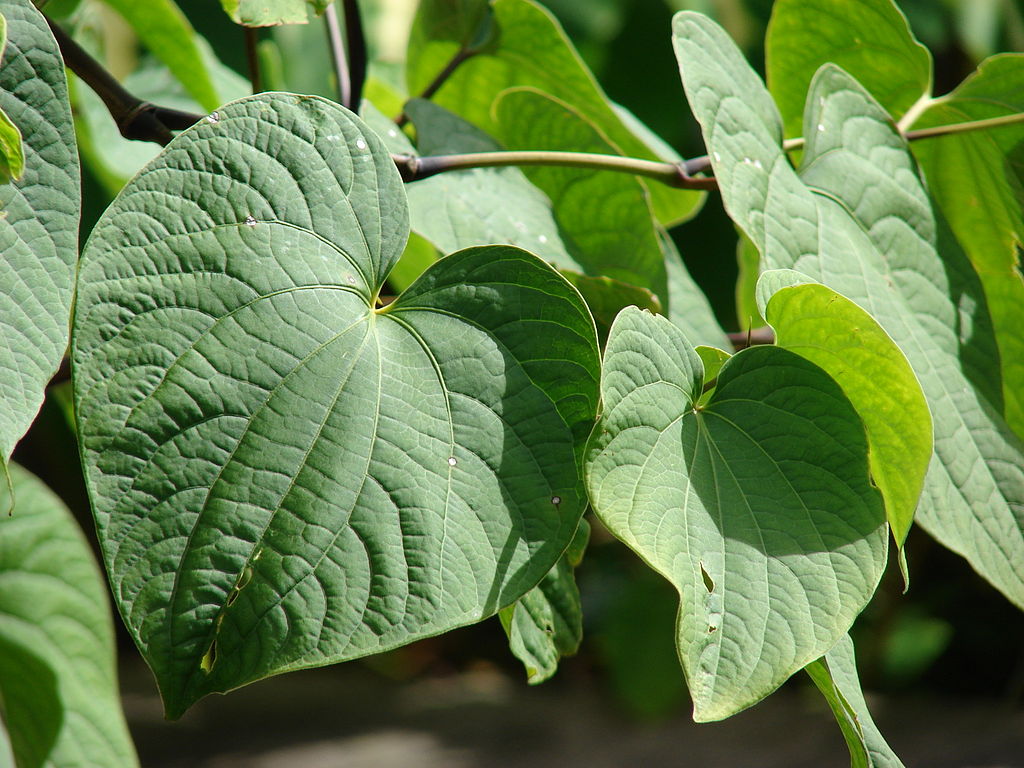
Piper methysticum Forst. f. Pl. Esc. Ins. Oc. Austr. 76. 1786, FI. Ins. Austr. Prodr. 5. 1786; Seem. FI. Vit. 260. 1868; C. DC. in DC. Prodr. 16(1): 354. 1869; Drake, Ill. FI. Ins. Mar. Pac. 274.1892; C. DC. inCandollea 1:180.1923; Guillaumin in J. Arnold Arb. 13:82. 1932; Christophersen in Bishop Mus. Bull. 154:6.1938; A. C. Sm. in J. Arnold Arb. 24: 353. 1943; Yuncker in Bishop Mus. Bull. 178:44. 1943, in op. cit. 184:34. 1945, in op. cit. 220:93.1959; J. W. Parham, Pl. Fiji Isl. 221. jig. 78. 1964, ed. 2. 308. fig. 91. 1972; Fosberg in Phytologia 13: 238. 1966; Sykes in New Zealand Dept. Sci. Indust. Res. Bull. 200:168. 1970; St. John & A. C. Sm. in Pacific Sci. 25: 325. 1971; B. E. V. Parham in New Zealand Dept. Sci. Indust. Res. Inform. Ser. 85:19. 1972; A. C. Sm. in Bot. J. Linn. Soc. 71:4.pi. 1,A. 1975; non L. f. Suppl. 91 (pro syn. P. latifolii L. f. in Emendanda). 1781.
Macropiper methysticum Miq. Comment. Phyt. 36. t. 4, D. 1840, Syst. Piper. 217. 1843; Seem, in Bonplandia 9: 259. 1861, Viti, 442. 1862; B. E. V. Parham in Agr. J. Dept. Agr. Fiji 8 (1): 2. 1935.
Piper methysticum is widely cultivated in native gardens in Fiji and is also occasionally naturalized along trails from near sea level to 700 m. or perhaps higher. It is usually seen to be a shrub 2-3 m. high, with white spikes. Inflorescences have been noted between February and June but probably occur throughout the year.
Typification and nomenclature: In his first publication Forster noted the species from the New Hebrides and New Caledonia, subsequently noting its occurrence in the Societies, Tonga, and Hawaii; I am not aware of a lectotypification. The nomenclatural situation has been discussed several times (for a brief summary see my comments in Bot. J. Linn. Soc. 71:23-24. 1975). Piper methysticum L. f. (1781) may be considered as not accepted by the author in the original publication (ICBN, Art. 34.1), where it was replaced by P. latifolium L. f. [= Macropiper latifolium (L. f.) Miq.], thus permitting the legitimacy of Forster’s 1786 binomial.
Distribution: The nativity of Piper methysticum is uncertain, but probably it was indigenous in eastern Malesia or possibly in the New Hebrides; it is now widely cultivated eastward throughout the Pacific and is occasionally naturalized. It is certainly one of the first plants that aboriginal voyagers would have taken with them.
Local names and uses: Yanggona is the commonly used Fijian name, but sometimes the Polynesian kava has been adopted. The species provides an important beverage throughout Polynesia and in those parts of Melanesia, such as Fiji, where Piper betle is not used. The beverage, also known & yanggona or kava, is prepared from the fresh or dried roots or the lower parts of the stem, which are pounded into a pulp or powder and added to water. It is not an intoxicant but rather a mild narcotic, acting as a sedative or soporific. The beverage is, or at least was in the immediate past, closely connected with the entire social and political life of the people.
Available collections: VITI LEVU: Mba: Slopes of Mt. Nairosa, eastern flank of Mt. Evans Range, Smith 4008. Tailevu: Vicinity of Ndakuivuna, east of Wainimbuka River, Smith 7231. VANUA LEVU: Thakaundrove: Savusavu, Bierhorst F45', along trail from Mbiangunu to Vemsi, over Mt. Mariko, Bierhorst FI22. VANUA MBALAVU: Near Lomaloma, Garnock-Jones 1063. LAKEMBA: Near Tu- mbou, Garnock-Jones (coll. E. Delai) 863, 864. Fiji without further locality, Seemann 568.
Piper methysticum is one of those species that collectors ignore because of its abundance in village gardens. There are many cultivars, indicated by Fijian names (J. W.Parham, 1964, 1972). Interesting, if somewhat prejudiced, remarks about the use of yanggona a century ago are provided by Seemann (1865).
Piper methysticum is native to Melanesia, but was introduced throughout the high islands of Polynesia by ancient voyagers. It thrives in wet, somewhat shady places, and in Tonga is commonly cultivated in plantations. Since only male plants are known in Polynesia, kava is unable to reproduce by itself; stands of it in native forest are relicts of former cultivation. The plant is a woody shrub up to 4 m in height. The green stems have swollen nodes, and arise from a woody rootstock. The simple, alternately arranged leaves have a cordate blade 9‒13-veined from the base and up to 30 cm long. The male flowers are arranged in solitary, axillary, greenish white spikes up to 6 cm long, arising from an axil opposite a leaf. The female flowers and fruits are unknown.
Copyright ©2018. This sandbox portal development is powered by Symbiota software. Usage Policy.


